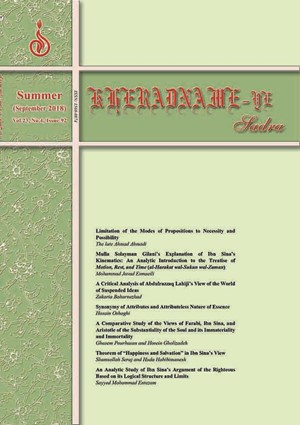-
-
List of Articles
-
Open Access Article
1 - Forewodr
Seyyed Mohammad Khamenei -
Open Access Article
2 - Limitation of the Modes of Propositions to Necessity and Possibility
Ahmad Ahmadi -
Open Access Article
3 - Mulla Solayman Gilani’s Explanation of Ibn Sina’s Kinematics: An Analytic Introduction to the Treatise of Motion, Rest, and Time (al-Harakat wal-Sukun wal-Zaman)
Mohammad Javad Esmaeili -
Open Access Article
4 - A Critical Analysis of Abdulrazzaq Lahiji’s View of the World of Suspended Ideas
Zakaria Baharnezhad -
Open Access Article
5 - Synonymy of Attributes and Attributeless Nature of Essence
Hosain Oshaqi -
Open Access Article
6 - A Comparative Study of the Views of Farabi, Ibn Sina, and Aristotle of the Substantiality of the Soul and its Immateriality and Immortality
Qasim Pourhassan Hosein Gholizadeh -
Open Access Article
7 - Theorem of “Happiness and Salvation” in Ibn Sina’s View
Shamsollah Seraj Huda Habibimanesh -
Open Access Article
8 - An Analytic Study of Ibn Sina’s Argument of the Righteous Based on its Logical Structure and Limits
-
Open Access Article
9 - 22th congress on Mulla Sadra
Seyyed Mohammad Khamenei
-
The rights to this website are owned by the Raimag Press Management System.
Copyright © 2017-2026







